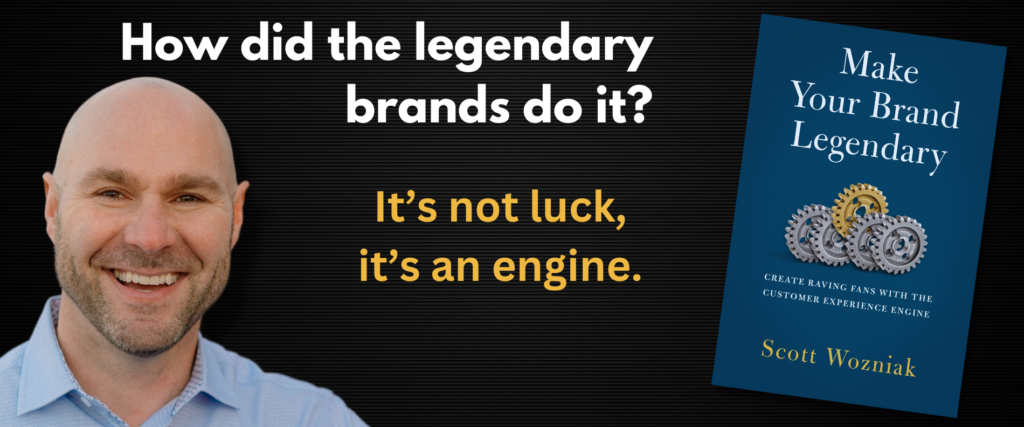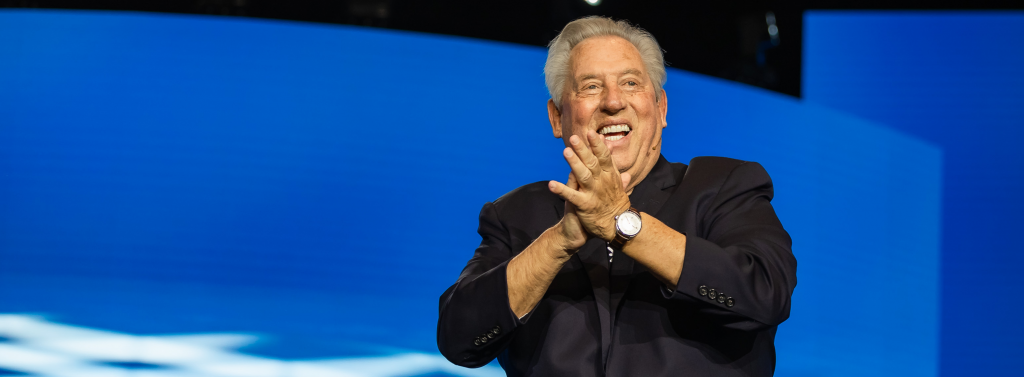Legendary Brands and the Engine that Runs Them

In each industry, you can usually find companies that stand out. If you run one of these stand-out businesses, your customers don’t just buy from you; they love you. They buy your T-shirts and stickers so they can declare to the world that they are associated with your company. They wait in long lines to be the first to have your latest release. They drive past your competitors’ locations to shop with you. They come back again and again to your store—which they probably consider their store—and engage with the staff like they’re personal friends. Some, like Harley-Davidson’s customers, even tattoo the logo on their bodies!
I probably don’t have to work too hard to convince you that this is true. I bet you’re a raving fan of someone yourself. It might be a sports team or a music group. It might be a big company or a nonprofit. It’s not all of us. Some of us are more reserved and cautious with our loyalty. But a whole lot of us have a particular brand that we truly love.
Why? What is it that these legendary brands do differently from their competitors? Why do their customers love them so much?
It’s not luck. Some companies have managed to do this year after year, decade after decade. It’s not a fluke; it’s a pattern. There are a series of systems that you can build which help you build trust, make personal connections and even inspire them to rave about you. There is an engine you can build that will make your brand legendary.
The Customer Experience Engine and You
I’ve spent more than 20 years inside some of the great brands of our time, including Chick-fil-A, Nucor Steel, and Disney World theme parks. In that time, I discovered a pattern they all follow. The details are different, but the principles are the same. Whether business-to-business or a consumer company, all these brands became great by building a Customer Experience Engine.
And here’s the best part: there’s nothing stopping you from building your own Customer Experience Engine. It doesn’t require more effort than running a regular company. In fact, it is actually easier to manage a Customer Experience Engine than a company without these systems. Yes, work is required to make the shift from no engine to engine, but none of the engine systems require you to have a genius-level intellect. None of the systems require a lot of money. Each individual step is something you can do without breaking the bank or burning out. And when you put them all together, they create raving fans—customers who are easier to deal with than regular customers and who make you more money!
Each part is a system, a combination of tools, tactics, and teams that serve as a critical piece of the engine. Individually, they’re really cool. Together, they’re really powerful.
1. CUSTOMER INSIGHT.
The fuel that drives the engine is customer insight. Do you really know your customers? Most companies we work with have customer data, not customer insight. They know what their customers buy, when they buy, maybe even where they live. But they don’t know why.
Why did they choose you over your competitors? What features of your service do they care about the most? What role do you play in their lives?
Your customer insight system might start with a simple survey. Or you could hire outside firms to talk to your customers, have AI analyze your current data. You might even conduct onsite visits and create focus groups. There are a lot of options, each with pros and cons. But whatever you choose, find a way to consistently generate customer insight.
The more you know your customers, the more effective all your efforts will be. Don’t guess; get customer insight.
2. OPERATIONAL EXCELLENCE.
The phrase “customer experience” often brings to mind things like parties and personal notes. But none of that matters if you don’t show up with operational excellence.
When most people think about excellence, they think of how smart their team is or about their proprietary tool. But the question your customer is asking first is not how special you are. You customers are asking, “Can I trust you?”
And the hard truth is that inconsistent excellence earns the same trust as consistent failure. You don’t get partial trust for partial excellence. So, before you attempt anything fancy, build a strong foundation of consistent excellence. This alone can create a strong reputation and grow your company.
And if you don’t get this right, nothing else matters. You can’t make up for sloppy operations with fancy customer service.
3. PERSONALIZED SERVICE.
Once your customers trust you, then they start asking, “Do you care about me?” All humans want to be seen and heard. They want to know if you notice them, or if they’re just another transaction. They want personalized service.
This is a small gear in the engine diagram for a reason. You don’t have to do a lot to make a big impact. If you have established trust through operational excellence, it often only takes one or two touches per year to make them feel cared for.
There are two methods to deliver personalized service: high touch and high tech.
- High touch: You can draw from the practices of Ritz-Carlton hotels, Disney World theme parks, and Michelin starred restaurants. You can use elevated language, send surprise gifts, and write personal notes.
- High tech: At the same time, you can use technology to allow you to be more proactive and personalized (especially with a large customer base), including leveraging a CRM fully and integrating AI into your communication systems.
If you want your customers to love you, then love on them first. Let them know that each of them matters to you as a person, not just as a revenue source.
4. MEMORABLE MOMENTS.
If you have implemented the other systems in the engine, then your customers love you. But that doesn’t mean they’re talking about you. There’s a world of difference between loving fans and raving fans. To get your people talking, you need to activate them by creating memorable moments.
The first mistake companies make in trying to get their customers to recommend them is to make the moment about how great the company is. They might even believe you are awesome, but they don’t want to tell your story. They want to tell their story.
So, to create a moment you invite them into an experience where your customer feels like the hero of the story. See, the question your customers are asking is, “How do I feel about myself when I’m with you?” This is usually subconscious, but it’s something we are all doing. Figure out a way to make them feel proud of themselves because they are associated with you.
Think about how Apple makes their customers feel like cool creatives or how Harley Davidson makes their customers feel wild and free. Talking about you becomes a way to prove to themselves and the world that they really are an awesome person.
Don’t hope they talk about you. Create a story-worthy moment, a memorable moment, and your customers will bring you more customers who will bring you more customers…
5. HEALTHY LEADERSHIP TEAM.
In the first version of the engine diagram, I didn’t have this element. That’s not because I don’t believe in leadership. I’ve written three books on leadership! I can’t mention everything you have to do to run a good company. You have to pay your taxes, but that’s not relevant to this strategy diagram.
But after working with several companies to implement the Customer Experience Engine, we realized that if the whole team doesn’t work together to make this happen for the whole company, it doesn’t work. If you implement half of the engine, you get none of the benefits. The systems have to work together to create raving fans.
So, the key word is “healthy.” Your team can’t be isolated people who report to the same boss. They have to function like a true team, collaborating on ideas, sharing resources, and holding each other accountable.
A healthy leadership team is not a separate gear, it’s the belt running behind all the other gears. It’s what keeps the whole organization in sync and moving forward. And it’s not optional. If you want to be a legendary brand, you have to forge a healthy leadership team.
It’s not magic; it’s an engine. It’s a stack of systems, all pointing in the same direction. It doesn’t require you to have a breakthrough product. It doesn’t require you to be in a “cool” industry. It doesn’t require a charismatic leader.
I’m not trying to hype you up. Success isn’t dependent on how motivated you are. It just requires that you build these five systems. When you set up these predictable processes, you will get a predictable outcome. It’s an engine, and every time I’ve seen a company operate with a Customer Experience Engine, I’ve seen it deliver the same result: customers who buy more, more often, pay full price, and tell others to buy from you.
Wondering how you can develop a Customer Experience Engine for your organization?
Check out the latest book from Maxwell Leadership, Make Your Brand Legendary: Create Raving Fans with the Customer Experience Engine.
Scott Wozniak is the CEO of Swoz Consulting, a firm that helps leaders build legendary lives and legendary brands. He has consulted with leaders on six continents, including Silicon Valley startups, family enterprises and Fortune 500 companies. Scott lives with his wife and four children in Atlanta, GA and in addition to speaking and consulting on multiple continents each year, he keeps pushing his boundaries by doing extreme sports, writing music, reading over 200 books a year and even founding a video game company.
More Articles

3 Ways Growth Gives You Hope

5 Key Traits of Resilient People









Be the first to comment on "Legendary Brands and the Engine that Runs Them"